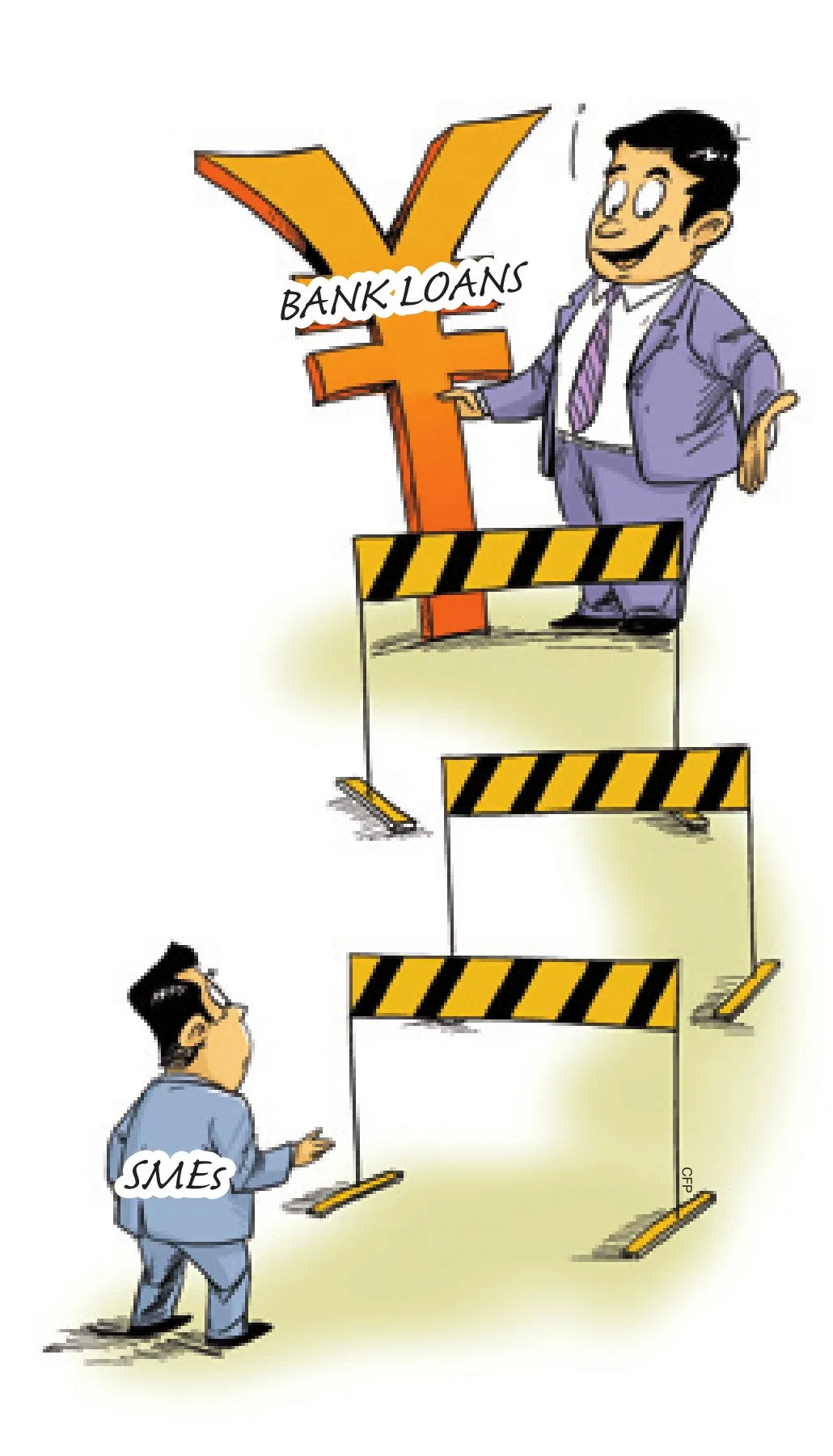Hidden From View
2012-06-07ChinashadowbankingsectorneedsmoreoversightandregulationByZhouXiaoyan
China’s shadow banking sector needs more oversight and regulation By Zhou Xiaoyan
Blamed in part for the U.S. subprime mortgage crisis, the shadow banking system has proliferated in China in recent years, arousing fears of possible economic instability.
Chinese fi nancial regulators sought to alleviate those fears at a news conference during the 18th National Congress of the Communist Party of China on November 11.
“Shadow banking is inevitable when there is a growing need for diversified financial services which traditional banks can’t provide,” said Zhou Xiaochuan,Governor of the People’s Bank of China(PBC), the country’s central bank, at the conference.
“But China’s shadow banking system is different from that in some developed countries and its size is much smaller.”

LET’S HELP YOU: A clerk offers consultation services to a client at a micro-credit company in Beijing.The company provides micro fi nance services to farmers, micro-sized companies and SMEs
In the West, the core of the shadow banking system is turning credit relations by traditional banks into securitized credit relations. Shadow banking activities have grown nearly threefold in the last 10 years.The estimated assets of shadow banking totaled $67 trillion as of the end of 2011, according to a report released by the Financial Stability Board (FSB), a Baselbased organization mandated by the Group of 20 economies to coordinate a regulatory response to the fi nancial crisis.
In China, there is no complete, uni fi ed or accurate de fi nition for its shadow banking system. Generally speaking, it refers to all non-bank loans, such as wealth management products with cooperation between banks and trust companies, underground finance, micro-credit companies, pawn shops, private financing, private-equity investment, hedge funds, and off-balancesheet lending transactions, wrote business commentator Yu Fenghui in his blog.
The PBC has introduced the concept of“social fi nancing,” which in addition to net new bank loans includes off-balance-sheet lending from banks, trust loans, corporate bonds and equity and funding from insurers, similar to Chinese shadow banking activities.
Social financing in the first three quarters of 2012 was 11.73 trillion yuan ($1.86 trillion), among which 43 percent was from credit access channels other than traditional banks, according to the PBC. The proportion has increased quite a bit during the past several years.
Shadow banking in developed countries is a product of fi nancial innovation, which is specially designed to evade regulation and supervision.
“Unlike in some foreign countries, most fi nancial activities by non-bank fi nancial institutions in China are under supervision,” said Zhou.
Trust products and money management products are within the supervision of the China Banking Regulatory Commission(CBRC),” said Shang Fulin, Chairman of the CBRC, at the same conference.
In October 2011, the CBRC required all financial institutions to report in detail their off-balance-sheet transaction activities.
Even though “we should remain alert and maintain effective supervision against all possible risks, we should encourage the diversification of China’s financial businesses,” said Zhou.
A forced move
Shadow banks are a reaction to China’s financing restrictions and tight monetary policies. Whilst the financing environment benefits government-background companies, many private fi rms, especially small and micro-sized ones, are ruled out of the lending decisions of banks, said Huang Yiping, a professor in economics at Peking University, in a paper titled Will China’s Shadow Banks Be Another Subprime Mortgage Crisis?
Small and medium-sized enterprises (SMEs)are never the main clients of commercial banks in China and banks have a high fi nancing threshold for them. In the past several years, China has stuck to prudent monetary policies, which intensi fi ed the cash-strained situation for SMEs.
In 2011, only 21 percent of SMEs managed to borrow money from traditional lending financial institutions such as banks and rural credit cooperatives, and around 20 percent of them have never borrowed any money, according to a survey jointly conducted by Peking University and the Alibaba Group in east China’s Zhejiang Province.
Around 50 percent of SMEs have to borrow money via non-bank channels such as private lending and from relatives, said the survey.
Yu also said that the dramatic increase of shadow banks in China is partly the result of an overly rigid fi nancial system.
“Serious defects in traditional fi nancial institutions, especially banks, have made it very difficult for the real economy, and SMEs in particular, to get enough fi nancing,” said Yu.“That’s why financing offered by non-bank financial institutions has taken off in China over the past several years.”
Supervision is key

Scrutiny of the shadow banking system has increased since the outbreak of the subprime mortgage crisis in the United States in 2008.
“Appropriate monitoring and regulatory frameworks for the shadow banking system need to be in place to mitigate the build-up of risks,” said the FSB report.
“There is still a vacuum of supervision in China’s shadow banking system,” said Yu. Some transaction activities in China’s shadowing banking system don’t receive much scrutiny, such as guarantee companies and micro-credit companies. They are not within the supervision of the PBC and the CBRC but are subject to oversight from regulatory bodies specified by local governments.
However, fi nancial supervision is quite specialized fi eld, and letting non-specialized local governments supervise them is far from enough,he said.
“This is the key reason for the rampant expansion of micro-credit companies, guarantee companies,loan sharks and illegal private banks in recent years,” said Yu.
“Despite the possibility of facilitating efficiency and economic growth, the shadow banking system is a high-risk business that needs stricter regulation and supervision,”Huang said. Several steps are needed to contain the risks posed by China’s shadow banking sector.
First, in the short run, supervisory bodies should formulate more rules and regulations for companies that are engaged in the shadow banking system. Second,a clear supervisory framework must be designed to manage this business. Finally, a deeper transformation of China’s financial system must be made, including a market-oriented interest rate regime. This will enable more companies to gain fi nancing from banks and China’s capital markets, said Huang.
While further oversight is necessary, Shang said, regulations should be formulated based on the speci fi c qualities that make up China’s shadow banking system.
“For the next step, the CBRC will further study the functions, scale, structure and risks of the shadow banking system in China, based on the actual reality in the shadow banking sector,” Shang said.
“Also, we will promote further bank reform and innovation to offer better and safer fi nancial services,” he added.
